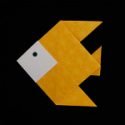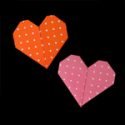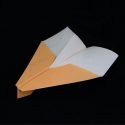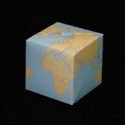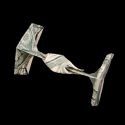Essential Jewelry Supplies
This page explains the jewelry supplies that you will need to start making your own jewelry.
Pliers:
pliers are a must have for anyone who wants to make their own jewelry. These hand held tools allow you to grasp, shape, mold, bend, and cut metal pieces. There are many types: round nose pliers, needle nose pliers, chain nose pliers, step jaw pliers, wire cutters, and more. Of these, you can also choose to have them straight or bent. The bent variety may be more comfortable on your hands as it allows you to hold the components without bending at the wrists. Beginner jewelry makers should have at least a pair of round nose pliers and wire cutters ($5 to $10 each). Alternatively, you can buy a kit with an array of different pliers ($30 to $50).
Pliers can be quite affordable, or they can be quite pricey. Beginners can survive with a cheap, or mini pair of pliers. However, if you plan to make your hobby into a business, then you should invest in good tools. Good pliers have comfortable padded handles, are contoured to fit nicely, are easy to squeeze, and may be spring loaded. These features will cause less stress on your hands.

General Jewelry Supplies
Findings
Small metal components used in jewelry making are collectively called findings. Findings come in a variety of metals such as gold, silver, bronze, brass, copper, pewter and hypoallergenic metal alloys.
Head Pins
a thin metal wire with a flat platform at one end. Beads and components are threaded onto the wire. The platform prevents the beads from slipping off. Some head pins have a decorative ball, bead, or pearl at the end instead of the flat platform.
See head pins here

Eye Pins
a thin metal wire with a loop at the end. Eye pins are similar to head pins except that there is a loop at the end instead of a flat platform. More components can be attached to the loop.
See eye pins here

Jump Rings
round metal rings that can be pried open and close. These are generic connectors which allow you to join jewelry components easily. They are often round, but can come in triangular, square, and other shapes.
See jump rings here

Split Rings
similar to jump rings except there is more overlap of the metal ring so the connection is more secure. These are preferred when working with heavy components or precious stones which you do not want to loose. These are similar to the rings used in keyrings.
See split rings here

Beads
beads come in many colors, sizes, and shapes (spherical, oval, tube, teardrop, faceted, smooth, irregular). They can be made of various materials (glass, plastic, metal, wood, bone, clay). Most beads are decorative and add shimmer, shine, and style.
Some beads are functional such as crimp beads or spacer beads.
See beads here

Crimp Beads
(or crimp tubes): are small metal beads with relatively large holes. These beads are often used as beginning or end beads because they hold other components in place. They can also be used to hide knots. Crimp beads are threaded in place then compressed with a crimp pliers. The compressed crimp bead acts as a stopper.
See crimp beads here.
Some people do not like the crimped appearance of a crimp bead, in this case a crimp bead cover can be used to wrap around and hide the compressed crimp bead.
See crimp beads covers here

Spacer Beads
fill up space so that expensive or showy beads need not be used. A basic spacer bead looks like a metal ball but decorative ones exist (rondelle and daisy being quite popular)
See spacer bead here

Jewelry Supplies for Earrings
Earring Posts
the front, decorative side of a stud earring.
See earring posts here

Earring Clutch
can be in the form of butterfly nuts or bullet clutches. They are the backside of a stud earring and are used in conjunction with earring posts. Earring clutches keep the earring post in place. They can be padded to give extra support.
See earring clutch here

Earring Hooks
(also called earring wires or fish hooks):
metal wires that is threaded into earring hole at the ear lobe; comes in a variety of shapes.
See earring hooks here

Jewelry Supplies for Necklaces & Bracelets
Jewelry Chains
metal chain links used in making necklaces, bracelets, and anklets. They can be made of gold, silver, brass, copper, aluminum, and other metals. Comes in varying diameters and designs.
See earring hooks here

Stretchy Cord
a plastic cord that is stretchable like an elastic band. Can be black or clear in color. Comes in spools of 5, 10, 25 or 100 meters. Choice of 0.5, 0.7, 0.8, and 1+ millimeters in diameter. Commonly used to make easy-slip-on bracelets.
See stretchy cord here

Leather Cord
leather or faux-leather cord for making necklaces, bracelets, and anklets. Comes in a variety of colors but most commonly in black or brown. Ranges from 1 mm to 3 mm in diameter.
See leather cord here

End Caps
are metal findings which attach to the end of cords. These caps have a loop where other jewelry components can be attached. Typically, they are used at the end of a leather cord where a clasp is to be added. End caps can be attached with glue or can be clamped on with crimping pliers. They can be plain or decorative.
See end caps here
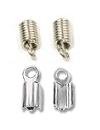
Clamshell Bead Tip
metal clips that can be pinched close. These devices open and close like a clam shell and are often used to clamp over knots when making bracelets and necklaces. The clips come with a hook where other components (such as a clasp) can be attached.
See clamshell bead tips here

Clasp
a two-part component used at the end of bracelets and necklaces which allow the jewelry to connect into a closed loop. There are many types:
- Spring Ring Clasp: is round in shape with a small lever which you depress to open/close the clasp.
- Lobster Claw Clasp: is teardrop in shape; has a small lever which you depress to open/close the clasp.
- S-Clasp: open/close clasp by bending the metal to widen/tighten the S shape; these have been around for many years; not well suited for repeated opening and closing, but are the standard used in many jewelry.
- Toggle Clasp: has a bar and a ring. The bar is passed through a ring and then positioned so the bar is perpendicular to the ring thereby allowing the clasp to lock close.
- Screw-On Clasp: has threads which allow you to screw on/off the two halves together.
- Magnetic Clasp: somewhat modern to the jewelry world; is easy to use and convenient especially for those who have difficulty manipulating small objects.
See clasps here
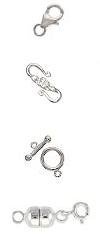
Jewelry Supplies for Brooches
Pin Backs
(also called Bar pins): used to make brooches and badges; similar to a safety pin with a wide bar where decorative component can be attached.
See bar pins here

-
Books with Origami Jewelry
- Origami Jewelry: More Than 40 Exquisite Designs by Ayako Brodek | (book review)
- Origami Jewelry Motifs by Julian Laboy-Rodriguez
- Origami Jewelry by Mayumi Jezewski and Marina Orry
- LaFosse & Alexander’s Origami Jewelry by Michael G. LaFosse and Richard L. Alexander
- Origami Jewelry: A Step-by-Step Guide by Monika Cilmi
Please Help
Please help by reporting broken links so that we can fix them. One easy message from you can save us hours and hours of clicking. Thanks!
-
More Origami Diagrams and Instructions…
-
These free origami instructions are made available to you by the paper folding community at large. If you have a diagram you would like to share, or if your diagram is listed here and you wish to have it removed, please Contact Us. Diagrams are intended for personal use. Copyright of the models lie with the origami creators and designers. Please contact the designer and/or creator directly for non-private usage of a model and/or artwork.









